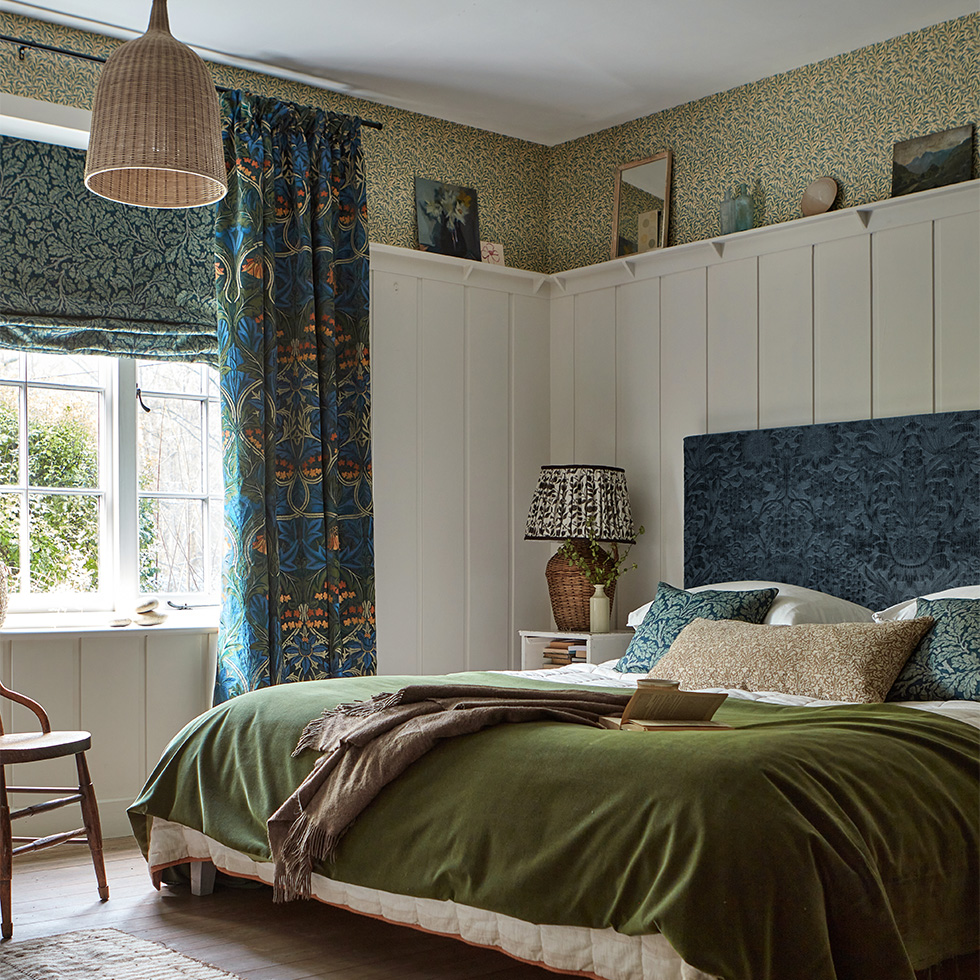‘The true secret of happiness lies in taking a genuine interest in all the details of daily life,’ goes the famous William Morris adage.
Dare we suggest this applies exceptionally well when taking the time to correctly fit a curtain pole? Our guide will take you through all the particularities of how to fit a curtain pole or curtain track, so you get it right the first time.
What you will need
- Your curtain pole or track
- Steel tape measure (it’s much more accurate than a fabric one)
- Drill with drill bit
- Screwdriver
- Step ladder
- Spirit level
- Cable detector
- Hacksaw
- Pencil


Understanding the Basics
Before you pick up any tools, please: gently drop them. Because first, we need to understand the key principles.
So, let’s be clear: curtains hang on a curtain pole, the pole sits above the window recess (the bit above, before the window goes ‘in’) – which is supported by brackets. At least two (sometimes three, if 60+ inches) brackets will be drilled into the wall that will bear the weight of the drapes and pole. Flanking the curtain pole are its finials. These are purely decorative and have no structural purpose. This differs from a curtain track; we’ll get onto the differences in a moment. That’s the pole; now onto the curtains. Curtains on a curtain pole can be held by eyelets (that’s loops within the curtain fabric) or hung by external loops. The length of the curtain is known as ‘the drop’, typically that’s the height of the window, or from the pole to the floor: you decide.
That’s the curtains’ height; now width. When the curtains are drawn, that’s called ‘the gather’. The gather is important. Because if you have especially heavy curtains, you need to consider creating extra space at the side of the window for that (thicker) material to gather. Getting a longer curtain pole could also be a wise decision.
The Differences Between a Curtain Pole and Track
Both hang curtains, but in different ways. A curtain pole hangs above a curtain, visibly on the outside recess of a window. A curtain track however can be fitted inside or outside the window recess and is not visible since it’s behind the curtain. On a curtain track, the curtains slide along the track when opened, whereas curtains on a pole do not, the curtains are pulled open. Curtain poles come in various styles and often have finials, whereas curtain tracks are not a design feature, because they are not made to be distinctly visible behind the curtain.
How to fit a curtain pole or track
STEP ONE: MEASURE THE POLE OR TRACK WIDTH
If you’ve already got your made to measure Morris & Co. curtains, or you’re waiting for them in the post: use this size for your pole or track width measurement.
If you haven’t yet measured for your curtains: you will need to measure the width for your pole or track. Measure the width of the window opening, and then adding an overhang to each side. For a typical window, we suggest poles or tracks should overhang the window by no less than 15cm each side (that’s excluding finials – the decorative end pieces of the curtain pole).
Mark the pole or track with a pencil, check your measurements again. Then cut the pole to the required width (excluding finials) using a hacksaw.
For wider windows, poles sometimes come in two parts with a centre bracket. You need to cut an equal amount off each half for your centre bracket to be in the middle for this two-part pole.
For curtain tracks: make sure there’s enough brackets to take the weight of the curtain (typically, this is harder for heavier curtains with thicker fabrics), and that they’re evenly spaced. A good way to check this is to test-assemble the brackets to the track to check suitable positions before fixing. Now mark the fixing positions.
STEP TWO: FIND THE BRACKET POSITION ALONG THE LENGTH
For curtain poles: brackets are typically fixed, so there’s room for at least one ring (hook, eyelet, or tab) between the outside edge of the bracket and the finial. Five centimetres is about right. If there’s a centre bracket, this should be fixed at the centre of the pole. Mark where the brackets are.
For curtain tracks: make sure there’s enough brackets to take the weight of the curtain (typically, this is harder for heavier curtains with thicker fabrics), and that they’re evenly spaced. A good way to check this is to test-assemble the brackets to the track to check suitable positions before fixing. Now mark the fixing positions.
STEP THREE: FIND THE BRACKET POSITION’S HEIGHT
If you already have your curtains (or they’re on order): To make sure your curtains hang correctly, your curtain pole or track needs to be installed at the right height relative to the curtain length. You'll need to determine where the top of the curtain aligns with the pole or track brackets. If your curtains need to reach a specific point, like the floor or windowsill, precision is crucial.
If you already have your curtains, assemble the pole or track, brackets, rings, and curtain on a flat surface to find the correct height for installing the brackets. This will help ensure they hang perfectly once mounted.
If you haven’t yet measured for curtains: The exact height for installing the brackets is less critical. It's suggested that the bottom of the pole or track is fixed at least 8cm (3 inches) above the top of the window frame. Note down the height where you plan to fix the brackets.
STEP FOUR: MARK THE BRACKET’S FIXING HOLES
Use a soft pencil to mark where you'll place the bracket fixing holes on the wall (or ceiling/soffit for top-fix installations). Double-check your marks and calculations for accuracy, to make sure it’s all correctly aligned. You may want to use a spirit level, but for curtains hanging to the floor or sill, it's best to align the pole or track with these reference points.
STEP FIVE: CHECK IT’S SAFE TO DRILL INTO YOUR WALL
Before you drill into your wall, you need to make sure there are no cables or pipe work in the rough area. Be sure to use a wall detector you can buy from a hardware store to do this, if you’re unsure, contact a professional.
You can also check if there are obstructions (like cables or pipes) by gently probing the wall using a bradawl (that’s a small screwdriver). Modern homes often have a cavity between plasterboard and blockwork where obstacles may be present. But it’s always best to get professional help, if you’re not sure.
STEP SIX: FIX THE BRACKETS ONTO THE WALL
Create starter holes with a bradawl, making sure the holes are large enough for your wall plugs. For solid walls, or for heavier curtains: use a drill to make deeper holes. But for cavity walls, you can snugly fit screws into the plasterboard or use specialist plasterboard fixings.
STEP SEVEN: PREPARING THE CURTAIN/TRACK
Now, you need to attach the right rings or gliders. Remember to leave one ring between the pole bracket and finial on each side. Finally assemble the pole or track onto the brackets.
You have successfully learnt how to fit a curtain pole and track for when your lovingly crafted made to measure curtains arrive in your chosen heritage patterns!
Our team is on-hand to help with any queries about drapes, blinds, fabrics, upholstery, alongside our useful guides that break down the step by step process of how to measure, and hang your beautiful new curtains or blinds.

